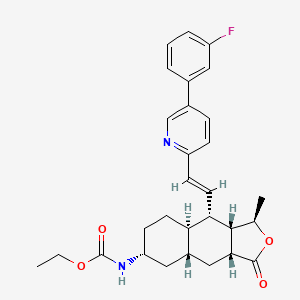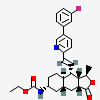Vorapaxar
- Vorapaxar
- 618385-01-6
- SCH530348
- SCH-530348
- Sch 530348
- Create:2006-10-25
- Modify:2025-01-04
 Vorapaxar Sulfate (active moiety of).
Vorapaxar Sulfate (active moiety of).
- SCH 530348
- SCH-530348
- SCH530348
- vorapaxar
- Zontivity
- Vorapaxar
- 618385-01-6
- SCH530348
- SCH-530348
- Sch 530348
- Vorapaxar free base
- UNII-ZCE93644N2
- CHEBI:82702
- ZCE93644N2
- CHEMBL493982
- DTXSID201009336
- 618385-01-6 (free base)
- ethyl ((1R,3aR,4aR,6R,8aR,9S,9aS)-9-((E)-2-(5-(3-fluorophenyl)pyridin-2-yl)vinyl)-1-methyl-3-oxododecahydronaphtho[2,3-c]furan-6-yl)carbamate
- ethyl N-[(1R,3aR,4aR,6R,8aR,9S,9aS)-9-[(E)-2-[5-(3-fluorophenyl)pyridin-2-yl]ethenyl]-1-methyl-3-oxo-3a,4,4a,5,6,7,8,8a,9,9a-decahydro-1H-benzo[f][2]benzofuran-6-yl]carbamate
- MK-5348
- VORAPAXAR (MART.)
- VORAPAXAR [MART.]
- [(1R,3aR,4aR,6R,8aR,9S,9aS)-9-[(1E)-2-[5-(3-fluorophenyl)-2-pyridinyl]ethenyl]dodecahydro-1-methyl-3-oxonaphtho[2,3-c]furan-6-yl]-carbamic acid ethyl ester
- ethyl n-[(3r,3as,4s,4ar,7r,8ar,9ar)-4-[(e)-2-[5-(3-fluorophenyl)-2-pyridyl]vinyl]-3-methyl-1-oxo-3a,4,4a,5,6,7,8,8a,9,9a-decahydro-3h-benzo[f]isobenzofuran-7-yl]carbamate
- Carbamic acid, ((1R,3aR,4aR,6R,8aR,9S,9aS)-9-((1E)-2-(5-(3-fluorophenyl)-2- pyridinyl)ethenyl)dodecahydro-1-methyl-3-oxonaphtho(2,3-c)furan-6-yl)-, ethyl ester
- CARBAMIC ACID,((1R,3AR,4AR,6R,8AR,9S,9AS)-9-((1E)-2-(5-(3-FLUOROPHENYL)-2-PYRIDINYL)ETHENYL)DODECAHYDRO-1-METHYL-3-OXONAPHTHO(2,3-C)FURAN-6-YL)-,ETHYL ESTER
- ETHYL ((1R,3AR,4AR,6R,8AR,9S,9AS)-9-((1E)-2-(5-(3-FLUOROPHENYL)PYRIDINE-2-YL)ETHEN-1-YL)-1-METHYL-3-OXODODECAHYDRONAPHTHO(2,3-C)FURAN-6-YL)CARBAMATE
- Ethyl [(1r,3ar,4ar,6r,8ar,9s,9as)-9-{(E)-2-[5-(3-Fluorophenyl)pyridin-2-Yl]ethenyl}-1-Methyl-3-Oxododecahydronaphtho[2,3-C]furan-6-Yl]carbamate
- Ethyl N-((1R,3aR,4aR,6R,8aR,9S)-9-((E)-2-(5-(3-fluorophenyl)pyridin-2-yl)ethenyl)-1-methyl-3-oxo-decahydro-1H-naphtho(2,3-c)furan-6-yl)carbamate
- Vorapaxar [USAN]
- Vorapaxar [USAN:INN]
- vorapaxarum
- Vorapaxar?
- Vorapaxar [INN]
- an-6-yl]carbamate
- Carbamic acid, [(1R,3aR,4aR,6R,8aR,9S,9aS)-9-[(1E)-2-[5-(3-fluorophenyl)-2- pyridinyl]ethenyl]dodecahydro-1-methyl-3-oxonaphtho[2,3-c]furan-6-yl]-, ethyl ester
- Carbamic acid, N-((1R,3aR,4aR,6R,8aR,9S,9aS)-9-((E)-2-(5-(3-fluorophenyl)-2-pyridinyl)ethenyl)dodecahydro-1-methyl-3-oxonaphtho(2,3-c)furan-6-yl)-, ethyl ester
- Carbamic acid, N-[(1R,3aR,4aR,6R,8aR,9S,9aS)-9-[(E)-2-[5-(3-fluorophenyl)-2-pyridinyl]ethenyl]dodecahydro-1-methyl-3-oxonaphtho[2,3-c]furan-6-yl]-, ethyl ester
- ethyl ((1R,3aR,4aR,6R,8aR,9S,9aS)-9-((E)-2-(5-(3-fluorophenyl)pyridin-2-yl)ethenyl)-1-methyl-3-oxododecahydronaphtho(2,3-c)furan-6-yl)carbamate
- Ethyl N-((3R,3aS,4S,4aR,7R,8aR,9aR)-4-((E)-2-(5-(3-fluorophenyl)-2-pyridyl)vinyl)-3-methyl-1-oxo-3a,4,4a,5,6,7,8,8a,9,9a-decahydro-3H-benzo(f)isobenzofuran-7-yl)carbamate
- MFCD16038876
- Vorapaxar (Standard)
- VORAPAXAR [MI]
- Vorapaxar (USAN/INN)
- VORAPAXAR [VANDF]
- Vorapaxar (MK-5348)
- VORAPAXAR [WHO-DD]
- MLS006010324
- SCHEMBL471187
- GTPL4047
- SCHEMBL3399110
- Vorapaxar (SCH 530348)
- B01AC26
- DTXCID801436165
- EX-A1343
- BDBM50261110
- HY-10119R
- s8067
- AKOS027326789
- CCG-269633
- CS-5527
- DB09030
- MK 5348
- AS-56098
- HY-10119
- SMR004701388
- NS00069583
- D09765
- EN300-21682214
- A1-03410
- Q7941753
- BRD-K93442924-001-03-4
- Z2568728886
- ((1R,3aR,4aR,6R,8aR,9S,9aS)-9-((E)-2-(5-(3-Fluorophenyl)-2-pyridinyl)vinyl)-1-methyl-3-oxododecahydronaphto(2,3-c)furan-6-yl)carbamate d'ethyle
- [(1R,3aR,4aR,6R,8aR,9S,9aS)-9-{(E)-2-[5-(3-fluorophenyl)pyridin-2-yl]ethenyl}-1-methyl-3-oxododecahydronaphtho[2,3-c]fur
- Ethyl ((1R,3aR,4aR,6R,8aR,9S,9aS)-9-((1E)-2-(5-(3-fluorophenyl)pyridin-2-yl)ethenyl)- 1-methyl-3-oxododecahydronaphtho(2,3-c)furan-6-yl)carbamate
- ethyl (1R,3aR,4aR,6R,8aR,9S,9aS)-9-((E)-2-(5-(3-fluorophenyl)pyridin-2-yl)vinyl)-1-methyl-3-oxododecahydronaphtho[2,3-C]furan-6-ylcarbamate
- Ethyl [(3aR,4aR,8aR,9aS)-9(S)-[(E)-2-[5-(3-fluorophenyl)-2-pyridinyl]ethenyl]dodecahydro-1(R)-methyl-3-oxonaphtho[2,3-c]furan-6(R)-yl]carbamate
- ethyl N-[(1R,3aR,4aR,6R,8aR,9S,9aS)-9-[(1E)-2-[5-(3-fluorophenyl)pyridin-2-yl]ethenyl]-1-methyl-3-oxo-dodecahydronaphtho[2,3-c]furan-6-yl]carbamate
- ethyl N-[(3R,3aS,4S,4aR,7R,8aR,9aR)-4-[(E)-2-[5-(3-fluorophenyl)pyridin-2-yl]ethenyl]-3-methyl-1-oxo-3a,4,4a,5,6,7,8,8a,9,9a-decahydro-3H-naphtho[6,7-c]furan-7-yl]carbamate
 Vorapaxar Sulfate (active moiety of)
Vorapaxar Sulfate (active moiety of)

H371 (100%): May cause damage to organs [Warning Specific target organ toxicity, single exposure]
H373 (100%): May causes damage to organs through prolonged or repeated exposure [Warning Specific target organ toxicity, repeated exposure]
H400 (100%): Very toxic to aquatic life [Warning Hazardous to the aquatic environment, acute hazard]
H410 (100%): Very toxic to aquatic life with long lasting effects [Warning Hazardous to the aquatic environment, long-term hazard]
P260, P264, P270, P273, P308+P316, P319, P391, P405, and P501
(The corresponding statement to each P-code can be found at the GHS Classification page.)
Aggregated GHS information provided per 2 reports by companies from 2 notifications to the ECHA C&L Inventory. Each notification may be associated with multiple companies.
Information may vary between notifications depending on impurities, additives, and other factors. The percentage value in parenthesis indicates the notified classification ratio from companies that provide hazard codes. Only hazard codes with percentage values above 10% are shown.
STOT SE 2 (100%)
STOT RE 2 (100%)
Aquatic Acute 1 (100%)
Aquatic Chronic 1 (100%)
Vorapaxar is associated with a low rate of serum enzyme elevations during therapy that was similar to the rate that occurred with placebo or comparator therapies. In a large controlled trial in over 10,000 patients monitored over a 2 year period, ALT elevations above 5 times the upper limit of normal occurred in 1% of vorapaxar vs 1.4% of placebo patients. In pooled analyses of laboratory studies from more than 39,000 patients receiving vorapaxar or placebo, GGT was the only liver test that was abnormal in a higher proportion of patients receiving vorapaxar (3.8%) than placebo (3.3%), and there were no reports of liver related serious adverse events or clinically apparent liver injury. Thus, liver injury from vorapaxar must be rare, if it occurs at all.
Likelihood score: E (unlikely cause of clinically apparent liver injury).
Patents are available for this chemical structure:
https://patentscope.wipo.int/search/en/result.jsf?inchikey=ZBGXUVOIWDMMJE-QHNZEKIYSA-N
Patents are available for this chemical structure:
https://patentscope.wipo.int/search/en/result.jsf?inchikey=ZBGXUVOIWDMMJE-HFLOQDIWSA-N
- Avoid herbs and supplements with anticoagulant/antiplatelet activity. Additive antiplatelet activity may increase the risk of bleeding. Examples include garlic, ginger, bilberry, danshen, piracetam, and ginkgo biloba.
- Avoid St. John's Wort. This herb induces the CYP3A metabolism of vorapaxar and may reduce its serum concentration.
- Exercise caution with grapefruit products. Coadministration of vorapaxar with moderate CYP3A4 inhibitors does not require intervention, but coadministration with strong inhibitors should be avoided.
- Take with or without food.
- CAS Common ChemistryLICENSEThe data from CAS Common Chemistry is provided under a CC-BY-NC 4.0 license, unless otherwise stated.https://creativecommons.org/licenses/by-nc/4.0/
- ChemIDplusVorapaxar [USAN:INN]https://pubchem.ncbi.nlm.nih.gov/substance/?source=chemidplus&sourceid=0618385016ChemIDplus Chemical Information Classificationhttps://pubchem.ncbi.nlm.nih.gov/source/ChemIDplus
- DrugBankLICENSECreative Common's Attribution-NonCommercial 4.0 International License (http://creativecommons.org/licenses/by-nc/4.0/legalcode)https://www.drugbank.ca/legal/terms_of_use
- EPA DSSToxCompTox Chemicals Dashboard Chemical Listshttps://comptox.epa.gov/dashboard/chemical-lists/
- European Chemicals Agency (ECHA)LICENSEUse of the information, documents and data from the ECHA website is subject to the terms and conditions of this Legal Notice, and subject to other binding limitations provided for under applicable law, the information, documents and data made available on the ECHA website may be reproduced, distributed and/or used, totally or in part, for non-commercial purposes provided that ECHA is acknowledged as the source: "Source: European Chemicals Agency, http://echa.europa.eu/". Such acknowledgement must be included in each copy of the material. ECHA permits and encourages organisations and individuals to create links to the ECHA website under the following cumulative conditions: Links can only be made to webpages that provide a link to the Legal Notice page.https://echa.europa.eu/web/guest/legal-noticeCarbamic acid, N-[(1R,3aR,4aR,6R,8aR,9S,9aS)-9-[(1E)-2-[5-(3-fluorophenyl)-2-pyridinyl]ethenyl]dodecahydro-1-methyl-3-oxonaphtho[2,3-c]furan-6-yl]-, ethyl esterhttps://echa.europa.eu/substance-information/-/substanceinfo/100.116.767Carbamic acid, N-[(1R,3aR,4aR,6R,8aR,9S,9aS)-9-[(1E)-2-[5-(3-fluorophenyl)-2-pyridinyl]ethenyl]dodecahydro-1-methyl-3-oxonaphtho[2,3-c]furan-6-yl]-, ethyl ester (EC: 612-523-7)https://echa.europa.eu/information-on-chemicals/cl-inventory-database/-/discli/details/51947
- FDA Global Substance Registration System (GSRS)LICENSEUnless otherwise noted, the contents of the FDA website (www.fda.gov), both text and graphics, are not copyrighted. They are in the public domain and may be republished, reprinted and otherwise used freely by anyone without the need to obtain permission from FDA. Credit to the U.S. Food and Drug Administration as the source is appreciated but not required.https://www.fda.gov/about-fda/about-website/website-policies#linking
- ChEBI
- FDA Pharm ClassesLICENSEUnless otherwise noted, the contents of the FDA website (www.fda.gov), both text and graphics, are not copyrighted. They are in the public domain and may be republished, reprinted and otherwise used freely by anyone without the need to obtain permission from FDA. Credit to the U.S. Food and Drug Administration as the source is appreciated but not required.https://www.fda.gov/about-fda/about-website/website-policies#linkingFDA Pharmacological Classificationhttps://www.fda.gov/ForIndustry/DataStandards/StructuredProductLabeling/ucm162549.htm
- LiverTox
- NCI Thesaurus (NCIt)LICENSEUnless otherwise indicated, all text within NCI products is free of copyright and may be reused without our permission. Credit the National Cancer Institute as the source.https://www.cancer.gov/policies/copyright-reuseNCI Thesaurushttps://ncit.nci.nih.gov
- Open TargetsLICENSEDatasets generated by the Open Targets Platform are freely available for download.https://platform-docs.opentargets.org/licence
- ChEMBLLICENSEAccess to the web interface of ChEMBL is made under the EBI's Terms of Use (http://www.ebi.ac.uk/Information/termsofuse.html). The ChEMBL data is made available on a Creative Commons Attribution-Share Alike 3.0 Unported License (http://creativecommons.org/licenses/by-sa/3.0/).http://www.ebi.ac.uk/Information/termsofuse.htmlChEMBL Protein Target Treehttps://www.ebi.ac.uk/chembl/g/#browse/targets
- ClinicalTrials.govLICENSEThe ClinicalTrials.gov data carry an international copyright outside the United States and its Territories or Possessions. Some ClinicalTrials.gov data may be subject to the copyright of third parties; you should consult these entities for any additional terms of use.https://clinicaltrials.gov/ct2/about-site/terms-conditions#Use
- Comparative Toxicogenomics Database (CTD)LICENSEIt is to be used only for research and educational purposes. Any reproduction or use for commercial purpose is prohibited without the prior express written permission of NC State University.http://ctdbase.org/about/legal.jsp
- IUPHAR/BPS Guide to PHARMACOLOGYLICENSEThe Guide to PHARMACOLOGY database is licensed under the Open Data Commons Open Database License (ODbL) https://opendatacommons.org/licenses/odbl/. Its contents are licensed under a Creative Commons Attribution-ShareAlike 4.0 International License (http://creativecommons.org/licenses/by-sa/4.0/)https://www.guidetopharmacology.org/about.jsp#licenseGuide to Pharmacology Target Classificationhttps://www.guidetopharmacology.org/targets.jsp
- Therapeutic Target Database (TTD)
- DailyMed
- European Medicines Agency (EMA)LICENSEInformation on the European Medicines Agency's (EMA) website is subject to a disclaimer and copyright and limited reproduction notices.https://www.ema.europa.eu/en/about-us/legal-noticeZontivity (EMEA/H/C/002814)https://www.ema.europa.eu/en/medicines/human/EPAR/zontivity
- EU Clinical Trials Register
- WHO Anatomical Therapeutic Chemical (ATC) ClassificationLICENSEUse of all or parts of the material requires reference to the WHO Collaborating Centre for Drug Statistics Methodology. Copying and distribution for commercial purposes is not allowed. Changing or manipulating the material is not allowed.https://www.whocc.no/copyright_disclaimer/
- Japan Chemical Substance Dictionary (Nikkaji)
- KEGGLICENSEAcademic users may freely use the KEGG website. Non-academic use of KEGG generally requires a commercial licensehttps://www.kegg.jp/kegg/legal.htmlAnatomical Therapeutic Chemical (ATC) classificationhttp://www.genome.jp/kegg-bin/get_htext?br08303.kegTarget-based classification of drugshttp://www.genome.jp/kegg-bin/get_htext?br08310.keg
- Metabolomics Workbench
- NORMAN Suspect List ExchangeLICENSEData: CC-BY 4.0; Code (hosted by ECI, LCSB): Artistic-2.0https://creativecommons.org/licenses/by/4.0/VorapaxarNORMAN Suspect List Exchange Classificationhttps://www.norman-network.com/nds/SLE/
- PharmGKBLICENSEPharmGKB data are subject to the Creative Commons Attribution-ShareALike 4.0 license (https://creativecommons.org/licenses/by-sa/4.0/).https://www.pharmgkb.org/page/policies
- PharosLICENSEData accessed from Pharos and TCRD is publicly available from the primary sources listed above. Please respect their individual licenses regarding proper use and redistribution.https://pharos.nih.gov/about
- Protein Data Bank in Europe (PDBe)
- RCSB Protein Data Bank (RCSB PDB)LICENSEData files contained in the PDB archive (ftp://ftp.wwpdb.org) are free of all copyright restrictions and made fully and freely available for both non-commercial and commercial use. Users of the data should attribute the original authors of that structural data.https://www.rcsb.org/pages/policies
- Springer Nature
- Thieme ChemistryLICENSEThe Thieme Chemistry contribution within PubChem is provided under a CC-BY-NC-ND 4.0 license, unless otherwise stated.https://creativecommons.org/licenses/by-nc-nd/4.0/
- Wikidata
- WikipediaAmmonium dinitramidehttps://en.wikipedia.org/wiki/Ammonium_dinitramide
- Wiley
- PubChemPFAS and Fluorinated Compounds in PubChemhttps://gitlab.com/uniluxembourg/lcsb/eci/pubchem-docs/-/raw/main/pfas-tree/PFAS_Tree.pdf?inline=false
- Medical Subject Headings (MeSH)LICENSEWorks produced by the U.S. government are not subject to copyright protection in the United States. Any such works found on National Library of Medicine (NLM) Web sites may be freely used or reproduced without permission in the U.S.https://www.nlm.nih.gov/copyright.htmlPlatelet Aggregation Inhibitorshttps://www.ncbi.nlm.nih.gov/mesh/68010975
- GHS Classification (UNECE)GHS Classification Treehttp://www.unece.org/trans/danger/publi/ghs/ghs_welcome_e.html
- MolGenieMolGenie Organic Chemistry Ontologyhttps://github.com/MolGenie/ontology/
- PATENTSCOPE (WIPO)SID 404139918https://pubchem.ncbi.nlm.nih.gov/substance/404139918SID 404139943https://pubchem.ncbi.nlm.nih.gov/substance/404139943

